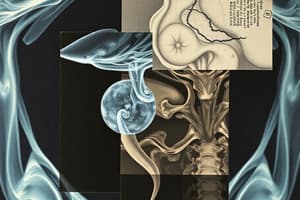Podcast
Questions and Answers
Why is plain radiography often the initial imaging modality for larynx investigations?
Why is plain radiography often the initial imaging modality for larynx investigations?
- It effectively assesses laryngeal trauma and precisely identifies the nature of soft-tissue swelling.
- It is readily available, cost-effective, and useful for initial assessment of soft tissues, air passages, foreign bodies, and trauma. (correct)
- It offers detailed visualization of disease processes without needing further imaging.
- It provides the highest resolution images for detecting subtle changes in the laryngeal cartilage.
What is the primary reason for obtaining both anteroposterior (AP) and lateral projections in larynx radiography?
What is the primary reason for obtaining both anteroposterior (AP) and lateral projections in larynx radiography?
- To create a 3D reconstruction of the larynx, improving diagnostic accuracy.
- To reduce the likelihood of patient motion affecting image quality.
- To provide comprehensive visualization of laryngeal structures from different angles, aiding in accurate diagnosis. (correct)
- To minimize radiation exposure by using two lower-dose images instead of one high-dose image.
In what situation would computed tomography (CT) or magnetic resonance imaging (MRI) be MOST appropriate for evaluating the larynx?
In what situation would computed tomography (CT) or magnetic resonance imaging (MRI) be MOST appropriate for evaluating the larynx?
- As a routine follow-up to confirm findings initially observed on plain radiographs.
- After plain radiography is inconclusive and a more detailed evaluation of disease processes is required. (correct)
- When a quick, initial assessment of potential foreign bodies is needed.
- When plain radiography sufficiently demonstrates the extent of soft-tissue swelling.
If a patient presents with suspected laryngeal trauma but the initial plain radiographs appear normal, what further imaging might be considered and why?
If a patient presents with suspected laryngeal trauma but the initial plain radiographs appear normal, what further imaging might be considered and why?
A patient has difficulty breathing, and a foreign body is suspected in their larynx. The initial radiograph is unclear. What imaging strategy is MOST appropriate?
A patient has difficulty breathing, and a foreign body is suspected in their larynx. The initial radiograph is unclear. What imaging strategy is MOST appropriate?
Flashcards
Larynx Radiography
Larynx Radiography
Imaging used to check soft-tissue swellings, airway effects, foreign objects, or trauma in the larynx.
Plain Radiography
Plain Radiography
Standard radiographic technique that uses X-rays to create images of structures in the body.
Computed Tomography (CT)
Computed Tomography (CT)
Advanced imaging that provides detailed cross-sectional images, useful for complex laryngeal issues.
Magnetic Resonance Imaging (MRI)
Magnetic Resonance Imaging (MRI)
Signup and view all the flashcards
Anteroposterior (AP) Projection
Anteroposterior (AP) Projection
Signup and view all the flashcards
Study Notes
- Plain radiography of the larynx is used to check for soft-tissue swelling and its impact on air passages.
- It can help locate foreign bodies or assess laryngeal trauma.
- Tomography, CT scans, and MRI can be used for further evaluation of diseases.
- Standard practice involves taking anteroposterior (AP) and lateral projections.
Studying That Suits You
Use AI to generate personalized quizzes and flashcards to suit your learning preferences.




